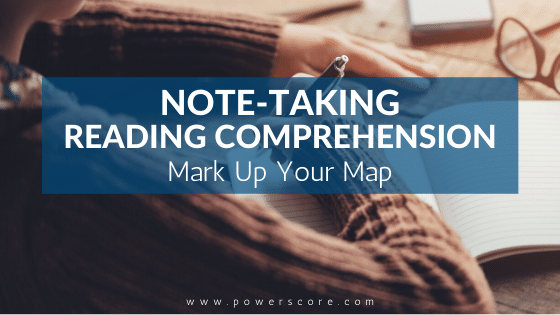Taking notes on Reading Comp passages can be a challenge for many students, especially because RC on the LSAT is so unlike RC on other standardized tests. Most students either forego note-taking altogether in favor of trying to “just get it”. Or else they go crazy underlining everything they think might be important somehow.
Neither of these strategies lends itself to the evidence-based approach you should take to answer the questions. Instead, what you need is a roadmap.
Using the Roadmap
Imagine that you are flying to a small town that you have never visited before. You’re going for a job interview. But you also plan to visit an old friend there and hang out for a few days before going home. You fly into the local airport and catch a cab to your hotel, and you ask the driver to take a circuitous route so that you can get a look around town before you check in. Now, here’s where you have to stretch your imagination. Pretend you are an old luddite like me and you are carrying a paper roadmap of the town with you.
As you wind through town, you pay attention to what you see. No getting distracted by the phone or zoning out! You might notice a few road names, just to stay oriented on your map, but by no means are you memorizing every twist and turn. You see a coffee shop that looks cool. So you quickly make a note on your map at its approximate location – “CS” in a little circle, perhaps. A few turns later you see office buildings and realize you are looking at where you will be going for your interview. So you again mark the map – “Ofc”.
Keep it Simple
You drive through a part of town that looks a little sketchy, and you decide to mark that, too. Maybe with a skull and crossbones symbol so you know to stay away from there. Then, a stretch of restaurants and bars along one street that look inviting, maybe where you and your friend will get together for dinner tomorrow night. Mark that stretch, maybe just the word “food.” Keep it simple! Be fast and efficient! You have to, really, because the cab is still moving and you don’t want to miss anything while you’re writing.
Now you arrive at your hotel, thank the driver, and check in. While you’re at it, you mark your map with an “H” to show where you are so that you can orient yourself later. You think briefly about your overall impressions of the town, because you might get a job offer and end up living there.
Now, after you check in, for some reason a guy in the lobby thinks you look like you must know the town, so he asks you if you know a good place to grab a cup of coffee. You don’t, of course, but you have your map! You whip it out and quickly show him your little “CS” notation. And you tell him to avoid the skull-and-crossbones section on his way there. You didn’t know how to get there, exactly, but you knew where to look, and were quickly able to see the right path and answer his question.
Make Notes to Find Items Later
That’s how you take notes on RC passages on the LSAT, folks! Don’t read with an eye towards “understanding” or memorizing anything. Don’t just underline what looks important. But use a variety of notes so you can tell the difference between those important-looking items. Don’t write paragraphs of detailed info, or even sentences summarizing each paragraph. Just note where things are so that you can quickly and easily find them later when asked, and only then do you read a little more closely to gather the specific info you need to answer the question you were asked. If they don’t ask about something, you didn’t need to know about it!
There’s more to it, of course. There’s prephrasing the Main Point and the Tone (which is what you were doing when you pondered your overall impressions of the town while waiting in line to check in at your hotel). And there’s getting familiar with the typical patterns so that you can better predict what questions you will get and take more efficient, effective notes. But those are subjects for another post (or for our Reading Comprehension Bible or one of our great courses). For now, consider how you take notes, and what notes you take, as a way of marking up a map to show you the way to find your best answers.
For more help with Reading Comp, check out some of these great blog posts:
- A Timing Strategy for Faster Reading Comprehension Performance
- The Fundamentals of Prephrasing: Part I
- Approaching Reading Comprehension Sections Strategically
As always, please share your comments and questions below!


pranav says
After reading this , I am certain that almost 99% of us have been taking notes the wrong way. This is so counter intuitive that the whole process needs to be immured in my mind all over again otherwise I might fall back to the old ways; this basically needs hard practice.